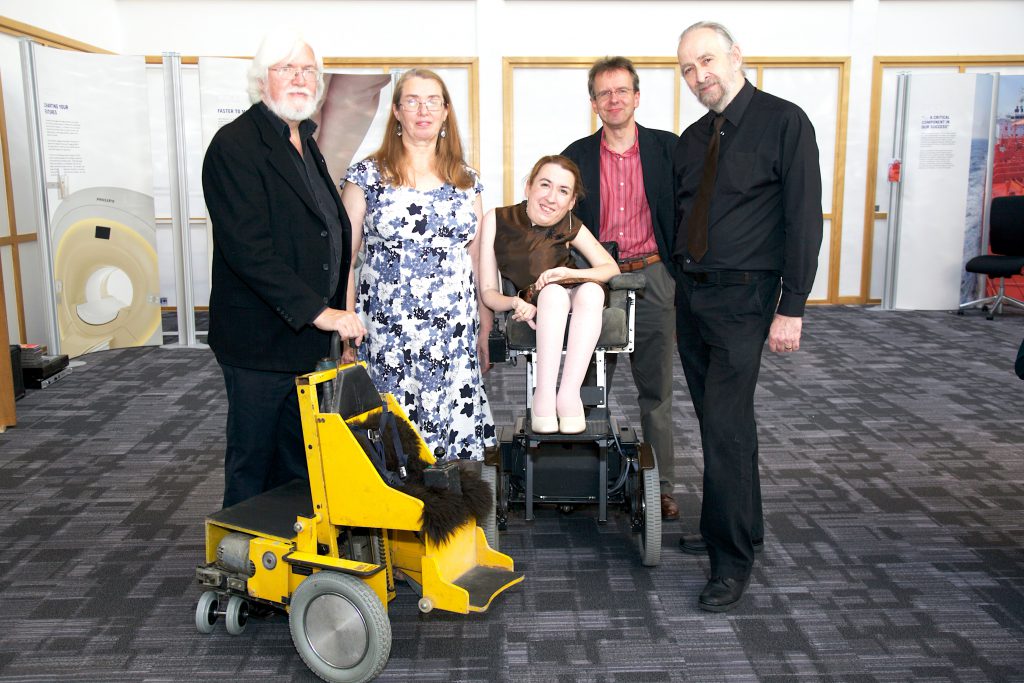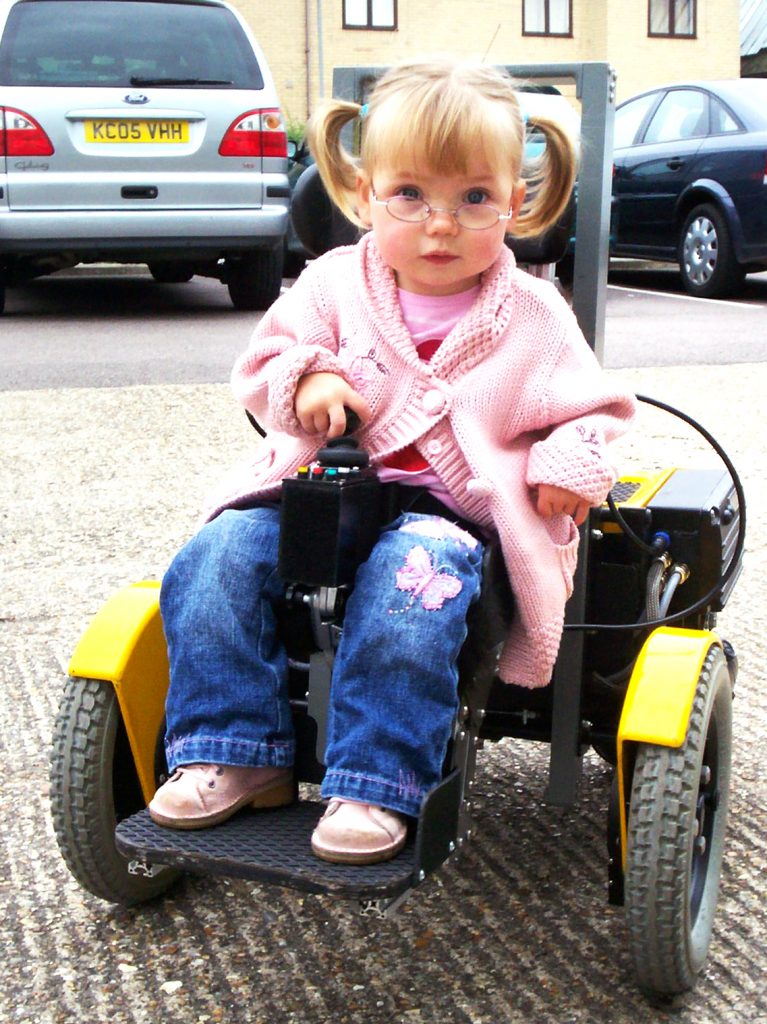Dragon mobility: Putting the user at the centre of wheel-chair design
Dragonmobility is changing the lives of active disabled people by building uniquely tailored power-chairs.
By Rute Costa
Dragonmobility’s story is Ruth’s story. At 18 months old, she was diagnosed with type 2 Spinal Muscular Atrophy, a condition “causing general muscle weakness”. The doctor that broke the news to her parents uttered the phrase: “she’s going to need wheels”. So Dan, her father and an engineering consultant in Cambridge, went looking for them. Ruth herself is sitting across the table from me. She has had to tell this story countless times, and yet she sounds as engaging as if it was the first. She explains further: “generally, if you have a need for something, someone else has needed it before, and so you can buy it. But he [Dan] discovered that was not the case” – there were no suitable chairs. Everyone told Ruth’s parents that she didn’t need a wheelchair until she was five, but they both knew that “leaving a child immobile until they’re five would, under any other circumstances, be considered cruel” and it would severely hinder their development. This encouraged Dan to join forces with his engineer friends and design a power-chair. “Ten weeks later I rode the first machine”, she concludes. I ask if she has any recollection, to which Ruth joyfully responds: “One of my earliest memories was being asked what colour I wanted, and I remember not knowing many colours”. She admits to have picked yellow “just because that’s the one I’d been learning”.
This first power-chair grabbed people’s attention not just because it was yellow. Ruth tells me her family were frequently stopped on the street and asked where they could get one from. The answer was, of course, “you can’t, we made it”. There was not a chair like that anywhere, with a seat able to go all the way up above seating height, and all the way down to the ground – all alternatives were grey, in colour and in possibility. And so, in the early 80s they started producing what they called the Turbo. “That revolutionised children’s wheelchairs”, Ruth explains. However, victim of the recession in 1990, the Turbo was lost. Following this setback, the family thought “right, we’ve done our bit, that’s it – we’re going back to our own lives, the paths we were on”. And yet they couldn’t. Ruth explains, with a tone of regret in her voice, that the wheelchair market didn’t offer the products she needed to maintain her lifestyle and level of integration: “and so we came back. That’s where Dragonmobility came from”.
“There was not a chair like that anywhere, with a seat able to go all the way up above seating height, and all the way down to the ground – all alternatives were grey, in colour and in possibility.”

“Why dragons?”, I ask. Ruth explains Dan has always liked fantasy stories about symbiotic relationships between dragons and humans, where they are “telepathically linked” and function as one body. This is the perfect analogy for their philosophy, and what I learn from Ruth about the differences between designing chairs for the carer and designing chairs for the individual explains why. “If you want to make life easier for the carer, it’s in your interest to give the disabled person a level of independence, but not so much that they become trouble – so there is a limit. If you are doing it for the disabled person themselves, it’s an issue of human rights, so there shouldn’t be a limit”. Dragons are limitless inasmuch as they offer as many possibilities of mobility to the individual as they can. They are also uniquely customised and tailored to the specific needs of their owners – “telepathically connected” to them. The kind of demand Dragonmobility has received, in the UK and abroad, shows that there is nothing out there quite like them. Every year they run a program for international customers, who come over for two weeks to learn everything they can about the machine, “and then fly home with it”. They have chairs all over Europe, in the US and Australia. However, because not all societies are suitably prepared, and because Dragonmobility is a small company producing bespoke products, they cannot reach everyone.
“Dragons are limitless inasmuch as they offer as many possibilities of mobility to the individual as they can.”
When asked about the challenges of being a small company with limited resources, Ruth says: “Often I tell everybody that we’re doing it the elves and the shoemaker style. We take what we’ve got, make the best of it, and we build that way”. She recounts the fairytale: a shoemaker is down to his last set of leather, and thinks he is about to make his last pair of shoes. Overnight, the elves transform that leather into the most beautiful pair of shoes the shoemaker has ever seen. The next day they get bought, giving the shoemaker enough money to buy two sets of leather. And so the elves make two pairs of shoes. These get sold, giving the shoemaker enough money to buy three sets of leather. And so on – it is easy to tell where this is going. Because Dragonmobility are trying to make their “shoes” as affordable as possible, they get no financial return, which means investment is scarce: “That’s the issue we have: finding people who want returns other than financial”. Ruth tells me that the aim is never to mass produce, just to be more efficient: the team is very keen to reach out to and benefit as many people as they can. Will is their expert fundraiser, advising and supporting families through the sometimes long and daunting process of finding funding. A Dragon is an expensive bespoke product, but the company is adamant that this shouldn’t stop anyone. Ruth emphasises they have the knowledge to guide the families that come to them, and their success rate is incredibly high: “we’ve never had to give up on funding”.

Money is not always Dragonmobility’s biggest challenge. In many ways, society is. Ruth tells me they have received interest from countries where “there needs to be more integration in the society before it [a power-chair] becomes appropriate”. She emphasises how much society conditions people with mobility impairments: “I read an article by Lisa Egan, where she says she prefers being called disabled because ‘person with a disability’ suggests that it is internal to her, whereas actually she has been disabled by the fact that her environment does not accommodate for the things she can’t do”. In other words, there aren’t always ramps or lifts where there are stairs. Now she directly addresses me, driving the point home: “You have a disability: you can’t fly. Fortunately we don’t have an environment that relies on you being able to. So you are not disabled by your inability to fly”. I ask her whether the UK is making progress in becoming more accessible: “In access, definitely; expectations, not so much”. Ruth is pressing that we need more integration, and that it should start with education: “If you segregate disabled children into an environment where they only interact with other disabled people, they’re never going to know how to handle integrated adulthood. It’s going to be a shock to them. Also, the able-bodied people have not been integrated”. Having grown up in an age of fully integrated education, Ruth is worried society is not fully moving forwards.
“Often I tell everybody that we’re doing it the elves and the shoemaker style. We take what we’ve got, make the best of it, and we build that way.”
Dragonmobility are doing the best they can to let people overcome these obstacles of access and integration. Where society allows them to build bridges, they are changing people’s lives. Ruth tells me the story of a girl aged 11, who had severe mobility impairment: “if mobility is impaired, language is impaired by the lack of mobility. It’s obvious: if you can’t chase the cat, you have no reason to shout ‘cat’. You have less use for language, so your vocabulary will be limited”. This girl’s teacher realised the connection between her vocabulary of 50 words and her disability, and found the solution in the then turbo. In 3 months, her vocabulary had gone up to 200 words. When the little girl’s brother came home from his military placement to celebrate a promotion, Ruth recounts, “he said: ‘Do you know what? None of that matters because my little sister came to the gate to meet me’”. Ruth also tells me of a client’s fiancé who, just before collecting his Dragon, confessed to be extremely excited about walking around town holding his hand, and about his newly acquired ability to plug and unplug devices around the house: “She listed this long list of things that we consider to be just life – but they’re actually life-changing”. The number of moving stories is endless, but Ruth finishes her sample of tellings with a joyful highlight:

“We’ve never been more proud than of a little boy who learnt not to chew his joystick ball. He had very severe learning difficulties, and anything he liked and was interested in went straight in his mouth. Of course the joystick was fascinating: because it did things! So his immediate reaction was to lean down and chew it, which made it quite difficult to move. There was a glorious day when his mum rang us and said: ‘He did it! He made it all the way across the garden, with his hand on the joystick and looking where he was going, and he did not chew the joystick ball!’ That’s wonderful!”
“If mobility is impaired, language is impaired by the lack of mobility. It’s obvious: if you can’t chase the cat, you have no reason to shout ‘cat’. You have less use for language, so your vocabulary will be limited.”
Dragonmobility’s long-term goal is to reach more people and be able to benefit more and more lives by passing on their expertise and support. Ruth confesses: “I hate having a conversation with someone when they go: ‘I wish we’d known about you three years ago’. And I think: ‘we were here three years ago, and we missed you – I’m sorry’. That’s hard”. Visibility is what the team is striving towards, so they can lessen the burden of young families “who have suddenly gone from ‘Oh wouldn’t that be a nice idea, should we have a baby and see what happens?’ to ‘my child isn’t going to walk and needs a power-chair: here is this huge new world’”. Their ultimate goal is to build a centre of expertise, a physical space that can harness all the knowledge that Dragonmobility have collected over decades, where people can visit to get support and advice on their options, and where experts can lecture, research and publish on disability.

Dragonmobility’s vision is invaluable and necessary in a cynical contemporary world where the rights of disabled people are constantly being challenged. Visit their page to learn how you can help them change people’s lives.
